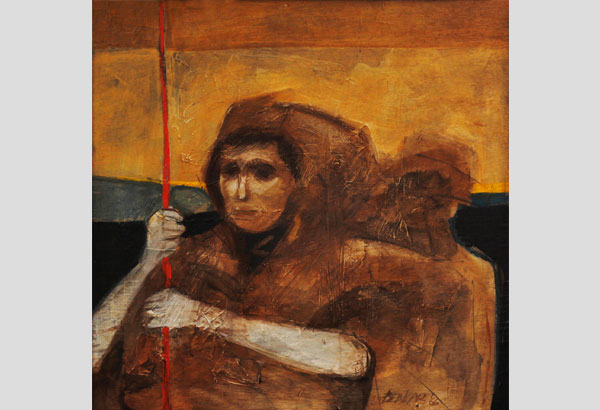The look askance: Luna’s signature mark

If I were to hazard what can be a possible signature mark of Juan Luna, it would have to be the look askance adopted by his women subjects. Usually solitary, well-dressed and full-bodied, they either cast a slight downward gaze as though they were mulling over a particularly fraught idea or stare meaningfully at the middle distance, trying to catch the attention of someone they know, someone beloved.
Within the ambit of her gaze, the viewer is not so much excluded as seen through, a ghost lurking in a secret world where the figure, caught in that crystalline time, has her own concerns to attend to. Her life may be depicted on canvas for all of us to see but her look suggests that we are breaching her privacy, that she is not a spectacle to be admired. A Luna portrait is almost always a stolen shot.
It is this same look that charges the face of the woman in the untitled work Luna painted in 1884 and which is the star piece among the 180 lots to go under the hammer at Leon Gallery’s “Magnificent September Auction” happening this Saturday (Sept. 12), at 2 p.m. Wearing a diaphanous sea green empire dress cinched at the waist with a pink sash and a pair of opera gloves, she offers, to an invisible figure, a slim metallic object (possibly a harmonica) whose sheen is repeated by a bangle clasping her wrist. While Luna may have finished the painting the same year as Spoliarium won the Madrid exposition, it doesn’t share the latter’s strict academic composition but is instead characterized by loose, impressionistic brushstrokes.

Another highlight is BenCab’s “Scavenger,” a work from his first solo show at Indigo Gallery which he established, along with his brother Salvador and friends, in 1966. The work was found in a Salvation Army sale for $4.99.
Any work purported to be a Luna should be scrutinized to the smallest detail. After all, he is to visual arts what Rizal is to literature. For this piece, the provenance “has been very well documented,” says Jaime de Leon, director of the auction house. “In fact, if you go to the Filipinas Heritage Library, you will see a documentation of this Luna.”
The work was bequeathed to National Artist for Historical Literature Carlos Quirino by his father, President Elpidio Quirino, who was given the painting as a gift by the monarchy during his state visit to Spain in 1951. The work was eventually acquired from the younger Quirino by the present owner who, by the looks of it, is ready to let go. While historical records still remain as the best authenticator of the piece, Jaime says that the eye will be quick to know that it’s genuine as it has the “quality of a one-look Luna. You know from afar this is a Luna.”
Curiously, the most recent work to enter the auction list is also noticeable for its eyes: Lynyrd Paras’ multi-media work in the shape of a headboard referred to as “Untitled” in the catalog but christened by the artist as “I Can’t Sleep, My Mind is On Fire.” “Lynryd conceptualized this considering that Leon (Gallery) has been known for furniture,” Jaime says. “The headboard is a typical 1950s to 1960s style evoking the Rococo.”

Lynyrd Paras’ multi-media work in the shape of a headboard — referred to as “Untitled” in the catalog but christened by the artist as “I Can’t Sleep, My Mind is On Fire” — features a woman artist who chases fugitive images in the dark of her subconscious.
Just like Luna’s, the work features a woman (shown with streaks of flowing hair) who, as an artist, chases fugitive images in the dark of her subconscious. Half-inspiration, half-material to her art, they are evoked by the implements of painting (a brush, a tube of paint and a bench on which to sit in order to confront the easel) alongside haunting metaphors: a skull to signify death, the folded body of a suicide, lurking sinister, doll-like figures.
A pair of eyes, vigilant and unflinching, hovers in the work, not once looking away from the scorching heat and intensity of the subject’s willful hallucinations. Paras exemplifies the commotion inside the subject’s head with his signature style of juxtaposing typography and imagery, essaying the untidy, explosive origin of creativity. For the artist, it can never be contained in a four-cornered canvas.
Other works of interest include BenCab’s “Scavenger,” a work from his first solo show at Indigo Gallery which he founded, along with his brother Salvador and friends, in 1966; Ang Kiukok’s “Seated Figure,” an important piece for any serious Ang Kiukok collector; and Fernando Zobel’s “Sin Titulo,” which plots the artist’s departure from his Serie Negra period to his late style characterized by luminous, floating colors girded with coruscating lines.
* * *
Leon Gallery is located at Eurovilla 1, Rufino corner Legazpi Streets, Legazpi Village, Makati City. For details, visit leon-gallery.com.



















